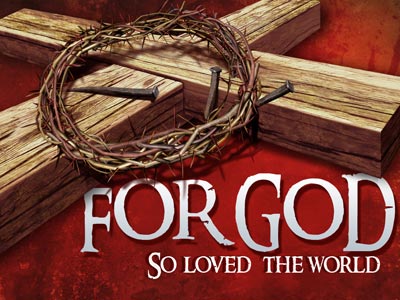-
Experiencing The Passion Of The Christ
Contributed by Robert Leroe on Nov 28, 2017 (message contributor)
Summary: The offense of the Cross, not the violence or lame charges of anti-Semitism, is what has riled up critics of Gibson’s movie.
Experiencing the Passion of the Christ
Rev Dr Robert G Leroe, Cliftondale Congregational Church, Saugus, Massachusetts
One thing Mel Gibson’s movie has given us all is an opportunity to talk about our faith in Christ. We all like discussing movies we’ve seen, and with the publicity surrounding this film we’ve been given a means to openly dialogue about our faith.
I went on Ash Wednesday to see the movie The Passion of the Christ, and the next day I went again, with my wife. I arrived just a few minutes after 12-noon. Normally on weekday afternoons, the theater is sparsely attended; yet when I entered the place was full, and I managed to get one of the last available seats. Looking around, I noticed that many people had received ashes. There was a palpable sense of hushed expectation as the lights dimmed.
By now you’ve read, as I, numerous accounts and reviews on the movie. Let me focus on one scene that moved me the most. Jesus is being questioned, and Peter is present; the crowd is getting stirred up by the false charges of blasphemy, when a man grabs Peter and cries, “I recognize you! You’re one of his disciples!” Peter, with terror in his eyes denies the charge; then another says, “Yes! I know you! You’re Peter, his follower!” Again Peter shakes his head, denies that he is Jesus’ follower and manages to break loose. Then a young woman confronts him, and Peter screams, “I don’t know him, damn you!” At that moment, you see Jesus look straight into Peter’s eyes and his soul. The moment hit me as it was supposed to, like a thunderbolt.
The brutality of Christ’s death was horrific, and graphic. Crucifixion was the worst kind of death imaginable in the Roman Empire, reserved for the worst criminals. As the soldier’s arm came down to nail Jesus to the cross, I recalled that it was, in fact, the director’s arm, Mel Gibson’s. Why? To make a statement--that it was his, and our sins that led Jesus to die. The movie opens with a quote which is the point of the entire movie, the Messianic prophecy of Isaiah 53:5, “He was wounded for our transgressions, He was bruised for our iniquities; the punishment that brought us peace was upon Him, and by His wounds we are healed.” The Just became a sacrifice for us, the unjust. Bear in mind that the worst part of Christ’s suffering was being the Sin-Bearer, and being separated from the Father. He cries out, “My God, My God, why have You forsaken Me?” a quote from Psalm 22. Luther described this as “God, forsaken by God.”
Flashbacks make the brutality somewhat easier to bear, so that that the scourging isn’t unrelenting; there are breaks to recover somewhat from the violence. I agree that it is not appropriate for children. There are many subtle artistic touches, which complement the narrative without appearing to be an overly extra-biblical attempt at artistic license. And there is a clear although brief Resurrection, showing the triumph of Jesus over the grave.
I do not recall any public outcry over movie violence from films that glorify violence as entertainment, such as Reservoir Dogs, Kill Bill, Pulp Fiction, The Texas Chainsaw Massacre, Terminator, or The Godfather. At the ticket counter at the theater I went to there was a sign warning people…yet I do not ever recall such a sign for other, more violent films. Andy Rooney on 60 Minutes criticized Gibson for making money from the Crucifixion; I suspect he has never criticized Quentin Tarrentino for getting rich over his films that are filled with gratuitous violence. No one complains about the appropriate violence--and money made from--other historic films, like Shindler’s List and Saving Private Ryan.
The Apostle Paul writes of the “offense” of the cross in Gal 5:11. The real issues of The Passion that rile people are first, (according to the Boston Globe) Gibson’s “absolutist, literal and simple” message, which is, “you’re either for us or against us.” I admit, this is, in fact, the message, the very words of Jesus. There can be no neutrality. The other offense comes from the fact that Jesus died as a sacrifice for sin; He died to pardon us. This means we need forgiving. It means we are sinners, something people may not care to hear, nor accept. “How dare you imply that I have such a need!” One Globe reviewer was overtly offended to be told by the movie that we need a Savior. It’s been said that if you really want to infuriate someone, forgive them! Like it or not: The bad news is that we’re sinners in need of forgiveness; the good news is that Jesus died to purchase our pardon.
The anti-Semitism of the movie is clearly Roman. You can see the contempt of the Romans towards the Jews throughout. Simon of Cyrene, forced to carry the cross of Jesus, is shown as a hero. A pilgrim in Jerusalem for the Passover, Simon became ceremonially defiled by touching the cross. He rebukes the Roman soldiers for mistreating Jesus and is venomously told, “Keep moving, Jew!” The movie, if anything, is anti-Italian. The buck stops at Rome. The Romans enjoyed beating Jesus because he was Jewish. The oldest Christian creed, the Apostles Creed, doesn’t even mention the Jewish nation; it says Jesus was “crucified under Pontius Pilate”, a weak politician who caved into a small special interest group that did not represent all Israel. He was already in trouble for misusing Temple funds to finance the building of an aqueduct and for allowing his soldiers to carry images regarded as idolatrous and offensive to the Jewish population. Gibson aptly points out to be anti-Semitic is to be anti-Christian. Gentile followers of Christ are, according to the Apostle Paul, the “seed of Abraham”. To hate Jews is, for Christians, self-hatred. The movie has some Jewish bad guys and good guys, but is not anti-Jewish.

 Sermon Central
Sermon Central



